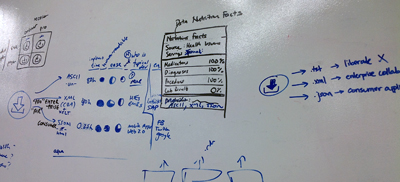Funding for Health Startups: SBIR awardee discussion
Funding for Health Startups: a discussion with SBIR awardee Transcendent International.
Blue Button Plus (Automated and Interoperable Blue Button) can provide a technology path for startups and innovators to build new products and services to help Americans with their health. But beyond, technology startups and small businesses have to think about practical matters like funding. What are ways that the federal government is trying to help health startups, particularly health tech startups, develop and commercialize businesses?
The Small Business Innovation Research (SBIR) program is a federally-funded program encourages domestic small businesses to engage in Federal Research/Research and Development (R/R&D) that has the potential for commercialization. Through a competitive awards-based program, SBIR enables small businesses to explore their technological potential and provides the incentive to profit from its commercialization. By including qualified small businesses in the nation’s R&D arena, high-tech innovation is stimulated and the United States gains entrepreneurial spirit as it meets its specific research and development needs.
The Blue Button for America (BBfA) team spoke with Bill Z. Tan and Vijay Bachani, of Transcendent International (TI), a Health tech startup and multiple SBIR awards winner, to help share key learnings and perspectives that can help other startups, particularly those looking to innovate and build small businesses on health data.
BBfA: How did your startup come to learn about the SBIR opportunity in the first place and pursue it?
TI: It was serendipitous. Right after 9/11, we were putting together a startup, and happened to read an article about a couple who were both scientists and had won a number of SBIRs to finance their startups. So we started Googling for it – it wasn’t through word of mouth because very few people were talking about it. And it took another 2-3 years before we really got serious about applying for our first project. If there’s a moral to the story, the SBIR program itself could use more publicity. So, first we were in disbelief there was a program like that! Then we looked into it and read into the application process, the job creation mandate and innovation desires on the federal governments’ part. It was a combination of looking at SBIR web site and choosing the NIH as a point of entry, and deciding on the right program which offered flexibility of, funding what’s called ‘investigator-initiated’ proposals, and not necessarily responding to specific topics issued by the agencies.
BBfA: If you could do it all over again, what would you do differently?
TI: Almost every aspect! The one part that cost us the most time and headache was the administration of the grants. At a certain point we had to set up specialized accounting for the SBIR funding, go through annual non-federal audits, put together all sorts of infrastructural pieces to support the operations of the grant. Our founder was doing a lot by himself, then we recruited a financial officer… but it literally took about 3 years to get to a place where we could consider it to be operationalized. That’s a lot of time away from the science and research. So we would have like to dedicate more time to building the business and the projects, less time on administration – maybe outsourced or found people who knew how to take us through the process. There have been a lot of people who come to us over the years wanting to learn about the SBIR program, and we have been considering the possibility of doing more than just sharing our lessons learned. Perhaps a more formalized platform – an incubator or accelerator of sorts – to help other entrepreneurs navigate the SBIR process and avoid some of the time-consuming and costly detours we’ve had to deal with.
BBfA: Do I need to find or hire someone to help with the process?
TI: Not at the beginning, in terms of the application process – the person who is best to write the proposal, even without prior experience or a technical background, is still the entrepreneur or principal investigator. Hiring someone to write a proposal is just paying them to take notes and regurgitate – probably doesn’t add much value. In terms of funding as well, as an entrepreneur, cash is a valuable resource that should be conserved to the extent you don’t have to give it up to help write the application. Once you’re funded, the expenses for hiring professional help are built into the budget – the government knows there is a cost to servicing the grants. After the grant is awarded, that’s when external help is tremendously useful. Not having to deal with the headaches of setting up the accounting, reporting, timesheet keeping and other grants management infrastructure is priceless. We cannot emphasize that enough. So is getting any help you can find to get to Phase III commercialization quickly.
BBfA: For startups, particularly in the health IT space, how would you position the role of SBIR funding relative to angel investment or venture capital & private equity?
TI: From our experience, most SBIR applicants are first-time entrepreneurs, and they could have gone to VC or Angel. It comes down to the nature of the business, not so much the stage of the entrepreneurial endeavors actually. When someone told me initially that this is really a five-year process of Phase I, Phase II and go-to-market, I didn’t believe them. As a typical startup founder in your 20s, you think you’re invincible and exceptional. But implementing a project well does take about 5 years. So, if someone is working on a consumer app and needs to constantly “pivot” and potentially “blow up” quickly, SBIR may not be the right fit. But for startups building enterprise health solutions with longer R&D and sales cycles, SBIR is perfect. In fact, these entrepreneurs probably wouldn’t even get VC funding for the long sales-cycle and R&D heavy risks, or may have to give up a great deal of equity and control in exchange. So, here is an area in the early stages where the SBIR is picking up the slack. And that’s part of the reason the program’s gotten more popular – it’s because other sources of funding are more scarce or less suitable. For the health IT market, even those startup ideas that involve a consumer app, entrepreneurs should definitely give it a shot, because all the advantages of SBIR still far outweigh the limitations. But a startup also should consider pursuing VC and Angels at the same time – it’s not an either/or situation. One challenge with SBIR is that the success rate is about 1:5 and 1:6, so the entrepreneur needs to be ready to revise and resubmit their proposal multiple times in order to stand a chance of being funded. It will take time away from making pitches to a VC or an Angel. The short answer: if you’re a health IT startup, do consider giving SBIR a try. The benefits of non-dilutive federal funding will also enhance your chance of success with a VC or angel investor down the road.
BBfA: SBIR offers a potentially non-trivial amount of funding for health startups – what are the ballpark expectations that startups should be aware of for Phase 1 and Phase 2?
TI: Phase I is generally in the $100-$150k range, and going past $1 million in Phase 2. We’ve had Phase 2 in the 2 million dollar range, and we’ve come across other companies with Phase II awards in the $3-4 million range. With the NIH so far, they have been flexible with topic and size of funding. But with the new reauthorization that’s passed by Congress there may be a harder cap now that all agencies have to enforce.
BBfA: How can health startups gear up to approach SBIR evaluation especially contrasted against VC pitches?
TI: There’s a fundamental difference between SBIR and VC pitches – and took us a while to appreciate the difference. In the VC space, they’re betting on the horse jockey and not the horse. Venture capitalists may even overlook what the product and business is, if the entrepreneur is someone they want to back. Whereas in the SBIR world, the reverse is almost true – they’re really betting on the science. The “jockey” almost becomes secondary. SBIR reviewers are scientists themselves, they’re looking at the merits of the science, and then the investigators behind the science, and they already expect that the team behind the science is someone with the necessary qualifications and credentials. That scientific qualification becomes the reassurance that the science can be carried out. Also, there is a funding cycle in the SBIR world. With most NIH applications, for example, there are three deadline dates, April 5th, August 5th, December 5th. Like many things in the public sector, it can take a while to for the process to unfold; four to five months after you submit your application, you find out what your score is. Based on your score, you find out the likelihood of funding, and then there may be another waiting period of a few months for the award to be processed. It may be wise to leverage the SBIR proposal preparation to hone your pitch, and approach VC and other funders while you wait to hear about your proposal.
BBfA: For startups in the health & health IT space in particular, what are good online search and awareness strategies on the SBIR.gov web site or elsewhere for startups to learn about funding opportunities?
TI: Definitely stay on top of the cutting edge of the science. We read many of the NIH newsletters to understand where the state of the science is so we can propose something meaningful and relevant. There are a couple of SBIR newsletters that come out once a week, and there’s a general one for NIH and individual ones for the institutes that come out once in a while. The same goes for people who are interested in applying for SBIR with the DoD, DoE and other agencies. Actually, I don’t usually go to SBIR.gov to look or search for topics; with the NIH, there’s a weekly email that announces all the new funding opportunities, including SBIR topics. BBfA: What does post-SBIR life look like for a startup, and how might it contrast to a non-SBIR-funded startup? TI: The SBIR does include a Phase III for commercialization efforts, but it’s not a structured phase and there’s no funding attached to it. Certain expenses such as sales, marketing and legal services are not allowable in the SBIR budget, and this creates what’s known as the ‘valley of death’, the funding gap that exits between the end of Phase II and the point where a company can become self-sustainable. This is a real challenge for a lot of companies in the healthcare IT space, especially those that sell enterprise solutions that have 1 to 2 year sales cycles. It’s even more challenging for biomedical and device companies that require regulatory approval. The good news is that there are efforts at the NIH and other agencies to help bridge that funding gap, such as the Phase IIb program; but not every agency offers it and not everyone qualifies. The important lesson here is for SBIR-funded companies to think about commercialization much earlier on – we mean on day 1 when they’re preparing their proposals – and look for any help they can get to take care of all the non-essential tasks so that they can focus on revenue generation and expedite the go-to-market process. Despite these challenges, which are going to happen to any company no matter SBIR-funded or not, the SBIR program is still by far the most attractive early-stage funding source around.
For more info about the SBIR, check out http://www.sbir.gov




